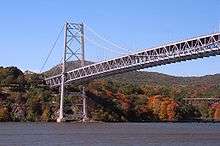Fort Clinton

Fort Clinton (demolished) was one of a pair of American Revolutionary War fortifications located at the confluence of the Popolopen Creek and the Hudson River. It stood on the south side of Popolopen Gorge, and its companion fort, Fort Montgomery, stood on the north side.[1] The forts defended a Hudson River Chain that stretched from Fort Montgomery on the west side of the Hudson River to Anthony's Nose on the east side. The sites of both forts are in present-day Highlands, Orange County, New York.

Fort Clinton's garrison of 300 soldiers was smaller than Fort Montgomery's, but it was built on higher ground, and its defenses were more complete. The fort was commanded by General James Clinton, for whom it was probably named.
On October 6, 1777, Forts Clinton and Montgomery were attacked by the British 63rd Regiment led by Sir Henry Clinton (no relation). The Battle of Forts Clinton and Montgomery was intense but brief: Both forts were overrun within an hour, and the wounded General James Clinton retreated with his men through Popolopen Gorge.[2] Fort Clinton and Fort Montgomery were razed by the British, and the iron chain they defended was dismantled.
Although the ruins of Fort Montgomery survive and the site is a National Historic Landmark, the Fort Clinton site was destroyed in the 1920s during the construction of U.S. Route 9W and the Bear Mountain Bridge.[3] Today, the Fort Clinton site is part of Bear Mountain State Park and is used for the Trailside Museum and Zoo.
References
- ↑ Adams, Arthur G., The Hudson River Guidebook, Fordham Univ Press, 1996 ISBN 9780823216796
- ↑ William Wade (1846). Panorama of the Hudson River. Archived from the original on October 25, 2007.
- ↑ Severo, Richard (May 24, 1998). "Revolutionary Fort Held Hostage to Decay and Apathy". The New York Times. Retrieved May 2, 2010.
External links
Coordinates: 41°19′15″N 73°59′17″W / 41.32083°N 73.98806°W